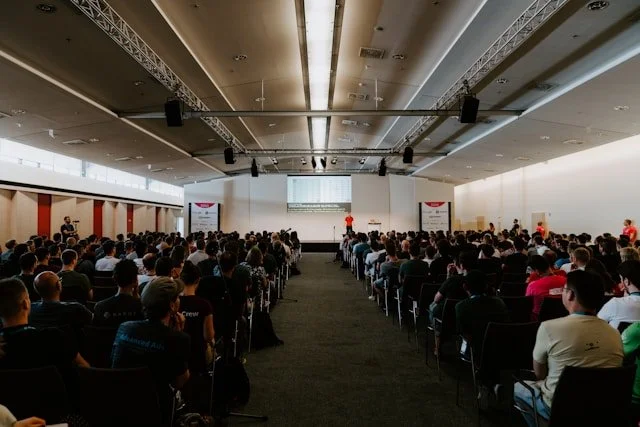With many communications and HR teams busy planning their internal conferences, here are some top tips to make the process easier and your conference a big success!
1. Find out what your people want and need to know
Communication should always be two-way. There’ll be things that your business and executive or leadership team need people to know and do, and they’ll be information and questions that your people will want answers to.
So can you do both? Yes, you can. Start by mapping out all the topics that you think should be covered and importantly the outcomes expected before you start planning the day, organising sessions, and contacting speakers.
Consider asking people what they want to get from the event and remember to engage your leadership and/or executive team early on in the process.
2. Collaboration will drive engagement
Organising an event in isolation will mean you miss out on some great insight and ideas from your colleagues. To avoid this, try bringing together a group of people from across your business to help shape the event and its contents.
This doesn’t mean that they need to be involved in the nitty gritty, or take on loads more on top of their day job, but having input from different parties and getting their feedback throughout the planning process, will make for a better event and a more engaged audience.
3. Mix things up a bit
Followed the same format for years? It’s time for a change! I’m sure you’re bored of planning the same event and chances are your people are too. So try and mix things up for each conference. Make sure you have a mix of speakers, panel discussions, workshops, break-outs, and activities.
Get different people to run the sessions, bring in external experts where relevant, and incorporate interesting tech to drive participation and add a bit of fun.
Oh and don’t forget the merch! People love to take stuff away so factor this in and give them something that is relevant to your event, and that they’ll find useful or enjoy, so it doesn’t just end up in the bin.
4. Don’t cram too much in
We’ve all been there. You’ve got a long list of speakers that ‘only need 10 minutes or so’, and before you know it your agenda could fill the pages of a novel.
As hard as it is, be firm on the time you have available for the conference element of the event so you have enough time for networking, coffee breaks, and the all-important conference lunch!
5. Support your speakers and presenter
It’s easy to breathe a sigh of relief once your speakers are confirmed, they have a brief and a deadline for presentations. However, much of the success of your event is reliant on the quality of the presentations, so it's worth investing time in helping the speakers not only with their visual presentations but also the delivery.
Consider investing in some presentation training for those that need a bit of a confidence boost. I’d also recommend creating a presentation template for the event that is used by all speakers, accompanied by clear guidelines for use!
6. Get comfortable with the tech
How many events have you been to where you can’t remember what the speaker was talking about but you can remember the video not working or that awkward moment when the slides didn’t work?
We’ve all been there and whilst you can’t plan for all eventualities, making sure that you and your participants are comfortable with the tech and that all AV requirements are in hand, will definitely make it more smooth running.
7. Leave time to practice
Allowing time for people to practice and doing an event run-through is well worth it, even if it is a bit of a logistical headache.
Try bringing presenters together in advance, even if it’s just for a 30-minute virtual call, to run through the event, what is happening, when, and any key information that they need to be aware of. Ideally, give them 15 minutes on the day to get comfortable with the stage, flick through their slides, and ask any last-minute questions they may have.
8. Incorporate recognition
As well as making sure you’re covering the topics front of mind for your people, now is also the time to recognise their hard work.
Look at how you can incorporate recognition into your leadership and people conferences, associate it with the theme of your conference as well as your organisational values, and give your people and teams the chance to celebrate their achievements.
9. Don’t miss out on valuable content
How often do you get an opportunity to interview a range of different stakeholders on key topics in one day? Events like this take a lot of planning and (money) so think about how you can create content – video, blogs, social media content to name a few – that will last for many months ahead.
Think about your different communications channels – both internal and external – what content can you create that would make an impact on these channels and how can you give it longevity beyond the conference?
Consider bringing in external partners to help with your filming requirements to ensure you make the most of this opportunity.
10. Ask for feedback
Excellent, the conference is over, it seemed to go ok and now you can go back to the million and one things you’re behind on. Stop!! Take a bit of time to ask everyone their views.
Try sending out a brief survey to gather feedback and invite people to submit ideas for future events. Meet up with the group that helped you plan the event and ask for their honest and constructive feedback. Doing this means you are already ahead of the game when it comes to planning the next event.
Face-to-face events are a key part of employee engagement and play a vital role in helping people to understand the strategy of a business and their role in helping to deliver it. Yes, they are time-consuming and aren’t cheap, but planned and delivered well, they can make a huge impact and will reap rewards.






